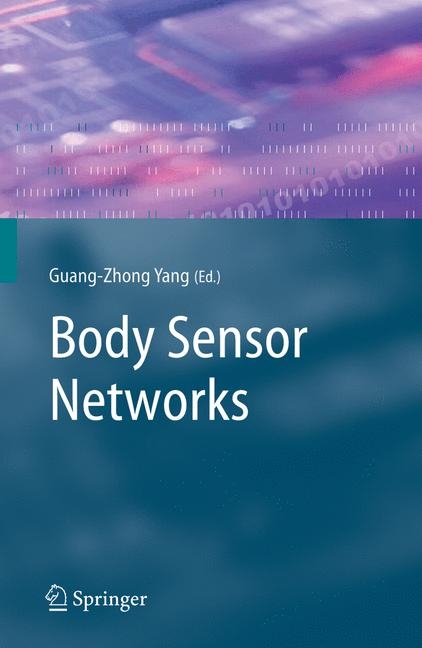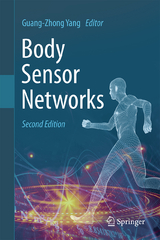
Body Sensor Networks
Springer London Ltd (Verlag)
978-1-84628-272-0 (ISBN)
- Titel erscheint in neuer Auflage
- Artikel merken
The last decade has seen a rapid surge of interest in new sensing and monitoring devices for healthcare and the use of wearable/wireless devices for clinical applications. One key development in this area is implantable in vivo monitoring and intervention devices. Several promising prototypes are emerging for managing patients with debilitating neurological disorders and for monitoring of patients with chronic cardiac diseases. Despite the technological developments of sensing and monitoring devices, issues related to system integration, sensor miniaturization, low-power sensor interface circuitry design, wireless telemetric links and signal processing have still to be investigated. Moreover, issues related to Quality of Service, security, multi-sensory data fusion, and decision support are active research topics. This book addresses the issues of this rapidly changing field of wireless wearable and implantable sensors and discusses the latest technological developments and clinical applications of body-sensor networks.
1 Introduction 1 1.1 Wireless Sensor Networks 1 1.2 BSN and Healthcare 4 1.2.1 Monitoring Patients with Chronic Disease 6 1.2.2 Monitoring Hospital Patients 7 1.2.3 Monitoring Elderly Patients 9 1.3 Pervasive Patient Monitoring 10 1.4 Technical Challenges Facing BSN 13 1.4.1 Improved Sensor Design 13 1.4.2 Biocompatibility 14 1.4.3 Energy Supply and Demand 15 1.4.4 System Security and Reliability 16 1.4.5 Context Awareness 18 1.4.6 Integrated Therapeutic Systems 19 1.5 Personalised Healthcare 20 1.6 Finding the Ideal Architecture for BSN 22 1.7 The Future: Going from 'Micro" to 'Nano" 27 1.8 The Scope of the Book 30 References 34 2 Biosensor Design and Interfacing 41 2.1 Introduction 41 2.1.1 What is a Biosensor? 42 2.2 How Do Electrochemical Devices Work? 44 2.2.1 Potentiometric Devices 45 Body Sensor Networks 2.2.2 Amperometry and Voltammetry 53 2.3 Instrumentation 65 2.3.1 Potentiometry 65 2.3.2 Amperometry and Voltammetry 66 2.3.3 Reference and Counter Electrodes 68 2.4 Photoelectrochemistry and Spectroelectrochemistry 69 2.5 Biocompatibility 71 2.5.1 Sensor Fouling 71 2.5.2 Tissue Damage 73 2.6 Novel Approaches to Handling Sensor Data 73 2.7 Conclusions 80 Acknowledgements 82 References 82 3 Protein Engineering for Biosensors 89 3.1 Introduction 89 3.1.1 Electrochemical Sensors 90 3.1.2 Optical Sensors 91 3.1.3 Gravimetric Sensors 92 3.1.4 Consuming and Non-Consuming Biosensors 92 3.2 Protein Engineering 93 3.2.1 The Signal Transduction Module 95 3.2.2 The Recognition Site Module 97 3.2.3 Immobilisation Module 100 3.3 Biocompatibility and Implantation 102 3.4 Conclusions 109 References 109 4 Wireless Communication 117 4.1 Introduction 117 4.2 Inductive Coupling 118 4.3 RF Communication in Body 119 4.4 Antenna Design 121 4.5Antenna Testing 125 4.5.1 Antenna Impedance and Radiation Resistance Measurement 125 4.5.2 Quarter Wave Line Impedance Measurement 126 4.6 Matching Network 128 4.6.1 Transmitter Tuning 128 4.6.2 The L Network 130 4.6.3 The p Network 131 4.6.4 The T and p -L Networks 132 4.6.5 Parasitic Effects 133 Contents 4.6.6 Network Choice 134 4.6.7 Radio Frequency Losses in Components and Layout Issues 135 4.6.8 Receiver Tuning 135 4.6.9 Base Station Antennas 136 4.7 Propagation 136 4.8 Materials 137 4.9 Environment 138 4.10 External Transceiver (Base Station) 138 4.11 Power Considerations 139 4.11.1 Battery Challenges 140 4.12 Defibrillation Pulse 141 4.13 Link Budget 142 4.14 Conclusions 142 References 143 5 Network Topologies, Communication Protocols and Standards 145 5.1 Network Topologies 145 5.2 Body Sensor Network Application Scenarios 148 5.2.1 Stand-Alone Body Sensor Networks 148 5.2.2 Global Healthcare Connectivity 149 5.2.3 Pervasive Sensor Networks 150 5.3 Wireless Personal Area Network Technologies 152 5.3.1 Overview 152 5.3.2 The Wireless Regulatory Environment 153 5.3.3 Wireless Communication Standards 155 5.3.4 IEEE 802.15.1: Medium-Rate Wireless Personal Area Networks 155 5.3.5 IEEE P802.15.3: High-Rate Wireless Personal Area Networks 158 5.3.6 IEEE 802.15.4: Low-Rate Wireless Personal Area Networks 160 5.3.7 ZigBee 164 5.3.8 Comparison of Technologies 168 5.4 Practical Experiences with IEEE 802.15.4 169 5.5 Healthcare System Integration 174 5.5.1 ExistingInteroperability Standards 174 5.5.2 Wireless Interoperability Standards under Development 176 5.6 Conclusions 177 References 180 6 Energy Scavenging 183 6.1 Introduction 183 6.1.1 Sensor Node Power Requirements 184 6.1.2 Batteries and Fuel Cells for Sensor Nodes 185 Body Sensor Networks 6.1.3 Ambient Ene
| Vorwort | M. Yacoub |
|---|---|
| Zusatzinfo | 243 black & white illustrations, 32 colour illustrations, 45 black & white tables, biography |
| Verlagsort | England |
| Sprache | englisch |
| Maße | 155 x 233 mm |
| Gewicht | 1037 g |
| Themenwelt | Mathematik / Informatik ► Informatik ► Betriebssysteme / Server |
| Informatik ► Software Entwicklung ► User Interfaces (HCI) | |
| Medizin / Pharmazie | |
| Technik ► Medizintechnik | |
| ISBN-10 | 1-84628-272-1 / 1846282721 |
| ISBN-13 | 978-1-84628-272-0 / 9781846282720 |
| Zustand | Neuware |
| Haben Sie eine Frage zum Produkt? |
aus dem Bereich



